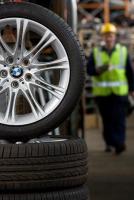Find parts for your car
Models
- 107 (3) Apply 107 filter
- 108 (2) Apply 108 filter
- 2008 (2) Apply 2008 filter
- 206 (1) Apply 206 filter
- 207 (1) Apply 207 filter
- 208 (9) Apply 208 filter
- 308 (2) Apply 308 filter
- 308 SW (2) Apply 308 SW filter
- Bipper (1) Apply Bipper filter
- Boxer (13) Apply Boxer filter
- Expert (12) Apply Expert filter
- EXPERT (8) Apply EXPERT filter
- Partner (12) Apply Partner filter
- Partner Origin (1) Apply Partner Origin filter
- Partner Tepee (1) Apply Partner Tepee filter
- RCZ (1) Apply RCZ filter
Used Peugeot Steering Rack Manuals
All used Peugeot Steering Rack Manuals listed on Breakeryard.com are tested, original (OEM) manufacturer parts and come with a 14 day money back guarantee. Breakeryard.com list cheap new OES or aftermarket car parts at discounted prices and used OEM car parts up to 80% cheaper than main dealer prices for Peugeot from premium breaker yards from across the UK.
About Steering Rack Manuals
The Peugeotmanual steering rack and pinion system consists of two main parts. The first of these is the pinion. This is a toothed, circular “gear” that connects to the steering column of the vehicle. The pinion rests on a linear “gear” known as the rack. When the steering wheel turns it causes the pinion to rotate. This rotation translates to linear movement of the rack.
The ends of the Peugeotmanual steering rack connect to rods, which are known as tie rods. These, in turn, are connected to spindles located on the vehicle’s wheels. When the rack moves from side to side, when prompted by the rotation of the pinion, the wheels are caused to move, thus translating the driver’s operation of the steering wheel to the directional movement of the vehicle.
To keep the mechanism of the Peugeotmanual steering rack in good working order it is essential to keep the ends clean and dry and also to ensure that they are adequately lubricated. This is achieved by encasing the steering rack within a set of rubber boots or gaiters.
If there are any problems with the Peugeotmanual steering rack as a result of wear and tear caused by water or dirt or lack of effective lubrication it is likely to require replacement if the steering system of the vehicle is to be restored.
Peugeot trivia
- It's hard to believe, but the Peugeot company was founded in 1810! Of course, it didn't make cars then. Instead, it built pepper mills, salt mills and, eventually bicycles. It wasn't until 1889 that the first Peugeot car was made (they only made four of them, and they were powered by steam).
- Lots of car manufacturers tried building electric vehicles at some point, but Peugeot had more success than others in the 1940s! Fuel restrictions promoted the design, and the car came with four 12-volt batteries that meant a range of 80km on a single charge and a top speed of 32km/h.
- All models of Peugeot have a number designation with a 0 in the middle. There's a persistent myth that this is because the designers wanted to integrate the starting handle, and chose the central 0 as the ideal way to hide the slot. There's no substance to that myth, but those numbers are an indication of the size and age of the car.
- Peugeot might not be a name in Formula 1 (they did try a few times, but it never quite worked out), but they have been dominant in other races. In particular, four victories in an incredible 24 hours at Le Mans, and six impressive wins in the Dakar rally, to name just a few.
- It was Armand Peugeot who turned the company into car manufacturing. He called the company the Société des Automobiles Peugeot (Peugeot Automotive Society) and was the one who approved the famous lion emblem that is still used today.







